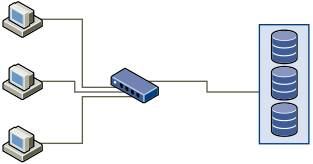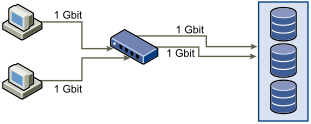A typical SAN consists of a collection of computers connected to a collection of storage systems through a network of switches. Several computers often access the same storage.
The following graphic shows several computer systems connected to a storage system through an Ethernet switch. In this configuration, each system is connected through a single Ethernet link to the switch. The switch is connected to the storage system through a single Ethernet link.

When systems read data from storage, the storage responds with sending enough data to fill the link between the storage systems and the Ethernet switch. It is unlikely that any single system or virtual machine gets full use of the network speed. However, this situation can be expected when many systems share one storage device.
When writing data to storage, multiple systems or virtual machines might attempt to fill their links. As a result, the switch between the systems and the storage system might drop network packets. The data drop might occur because the switch has more traffic to send to the storage system than a single link can carry. The amount of data the switch can transmit is limited by the speed of the link between it and the storage system.

Recovering from dropped network packets results in large performance degradation. In addition to time spent determining that data was dropped, the retransmission uses network bandwidth that can otherwise be used for current transactions.
iSCSI traffic is carried on the network by the Transmission Control Protocol (TCP). TCP is a reliable transmission protocol that ensures that dropped packets are retried and eventually reach their destination. TCP is designed to recover from dropped packets and retransmits them quickly and seamlessly. However, when the switch discards packets with any regularity, network throughput suffers. The network becomes congested with requests to resend data and with the resent packets. Less data is transferred than in a network without congestion.
Most Ethernet switches can buffer, or store, data. This technique gives every device attempting to send data an equal chance to get to the destination. The ability to buffer some transmissions, combined with many systems limiting the number of outstanding commands, reduces transmissions to small bursts. The bursts from several systems can be sent to a storage system in turn.
If the transactions are large and multiple servers are sending data through a single switch port, an ability to buffer can be exceeded. In this case, the switch drops the data it cannot send, and the storage system must request a retransmission of the dropped packet. For example, if an Ethernet switch can buffer 32 KB, but the server sends 256 KB to the storage device, some of the data is dropped.
Most managed switches provide information on dropped packets, similar to the following:
*: interface is up IHQ: pkts in input hold queue IQD: pkts dropped from input queue OHQ: pkts in output hold queue OQD: pkts dropped from output queue RXBS: rx rate (bits/sec) RXPS: rx rate (pkts/sec) TXBS: tx rate (bits/sec) TXPS: tx rate (pkts/sec) TRTL: throttle count
| Interface | IHQ | IQD | OHQ | OQD | RXBS | RXPS | TXBS | TXPS | TRTL |
|---|---|---|---|---|---|---|---|---|---|
| * GigabitEthernet0/1 | 3 | 9922 | 0 | 0 | 476303000 | 62273 | 477840000 | 63677 | 0 |
In this example from a Cisco switch, the bandwidth used is 476303000 bits/second, which is less than half of wire speed. The port is buffering incoming packets, but has dropped several packets. The final line of this interface summary indicates that this port has already dropped almost 10,000 inbound packets in the IQD column.
Configuration changes to avoid this problem involve making sure several input Ethernet links are not funneled into one output link, resulting in an oversubscribed link. When several links transmitting near capacity are switched to a smaller number of links, oversubscription becomes possible.
Generally, applications or systems that write much data to storage must avoid sharing Ethernet links to a storage device. These types of applications perform best with multiple connections to storage devices.
Multiple Connections from Switch to Storage shows multiple connections from the switch to the storage.

Using VLANs or VPNs does not provide a suitable solution to the problem of link oversubscription in shared configurations. VLANs and other virtual partitioning of a network provide a way of logically designing a network. However, they do not change the physical capabilities of links and trunks between switches. When storage traffic and other network traffic share physical connections, oversubscription and lost packets might become possible. The same is true of VLANs that share interswitch trunks. Performance design for a SAN must consider the physical limitations of the network, not logical allocations.